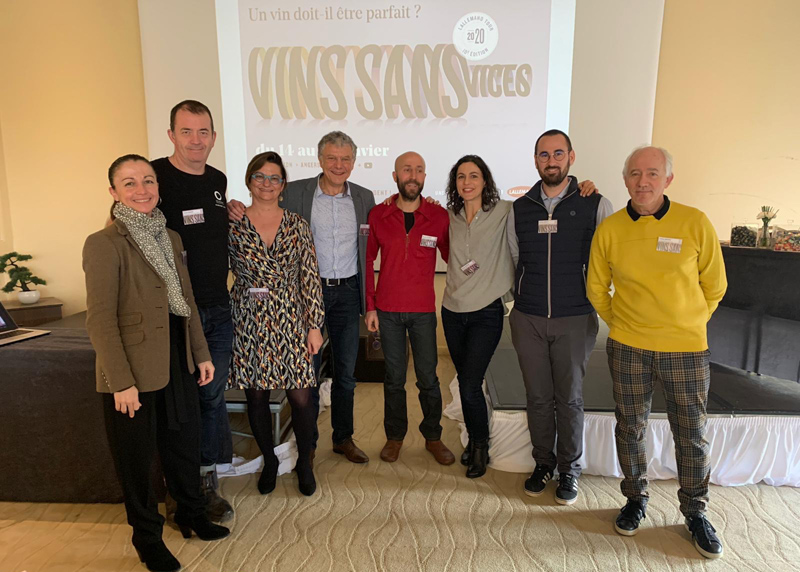
Randall Grahm is at it again. The Willy Wonka of the wine world has a new plan. No, it’s not global domination. Rather, it’s the creation of 10 000 new vine varieties as his legacy to the wine world. To this end, he has today launched an indiegogo crowd-funding initiative to raise some cash.
The idea is that these new varieties, bred to be disease and drought resistant, will best be able to express the terroir of his Popelouchum Estate in San Juan Bautista, which he bought with the proceeds from selling of some of his larger brands. Initially, Randall had plans to grow vines from seed on their own roots, but his ideas have since been refined after seeking advice from some vine experts, and now he plans to breed in a more targeted fashion.
It’s a hugely ambitious and interesting project, and it will be interesting to see the results. But this won’t be for some time. Breeding new grape varieties is a lifetime’s work.
There is, of course, no shortage of grape varieties already available for playing around with – around 1400 different varieties are currently grown commercially around the world. But there aren’t many new ones. As well as produce some fresh varieties with desirable characteristics, Grahm wants to take the chance to breed-in some resistance to disease. ‘The overall aim is to produce a distinctive, authentic wine of place in the New World and to model true sustainability,’ says Randall. ‘I’m building on some of the work that Professor Andy Walker of UC Davis has already done in conferring significant disease resistance on a number of vinifera varieties. He’s done this by crossing them with Vitis arizonica. The idea now is to take these grapes that are 97% vinifera and look at what might be done to really make them both maximally congruent to our set of growing conditions and at the same time also discover particular genotypes that have distinctive sensory characteristics,’ he explains.
‘The whole notion behind the initiative is really predicated on the idea that the New World has really been largely imitative of the Old – we haven’t yet discovered our unique and distinctive voice. My idea is that growing varietal blocks of grapes is quite limiting – we’ll never find the degree of congruence that the Old World has discovered with their centuries of iteration – but maybe by growing completely heterogeneous blocks, every vine genetically distinct from the other, we can produce a wine of real complexity, and allow the soil characteristics of the wine, rather than the varietal characteristics, to emerge.’
Randall has collected some wild Vitis berlandieri from Texas, which he says is the most drought resistant native grape you can find, and he has grown the seedlings up for rootstock. He describes this as potentially ‘very, very interesting’.
To realize the significance of what he’s trying to do, we need to look a little closer at the science of grape vines. What is a grape variety, and how is this different from a clone? A grape variety only comes about from sex: there is a mother variety and a father variety and the result is a new variety. Each of the plants of this new variety will be genetically identical, at least to start with. One example would be Cabernet Sauvignon, whose parents are Sauvignon Blanc and Cabernet Franc. If the new plant is propagated vegetatively, through cuttings, all the offspring will be the same variety. However, if Sauvignon Blanc and Cabernet Franc were crossed many times, each separate crossing would result in a new variety. This is because genes are jumbled up during sex, just as the same human parents produce kids who have quite different characteristics, although they may share a family resemblance.
Over time, with repeated vegetative propagation of the same vine variety, mutations appear, and when these occur in the actively dividing group of cells known as a meristem, they can cause a shoot to have different characteristics to the rest of the vine, and can then be transmitted through cuttings. These cuttings can then go on to make new vines in which all the parts of the vine carry this mutation. If mutations cause visible, favourable characteristics, they can then be selected deliberately (most mutations will not have any obvious effect). This selected vine with new characteristics is what is known as a clone. It’s still the same variety, but it is a little different.
Most of the grape varieties we have are quite old. The vines have not had sex for a long time. I can’t think of many new varieties at all. There’s Pinotage, produced in South Africa in the 1920s by crossing Cinsault and Pinot Noir. There’s also Marselan, a Cabernet Sauvignon/Grenache cross made in 1961. Any others?
What about Randall’s original idea, to grow vines from seeds? Almost all commercial varieties are hermaphrodite. This means that they can fertilize their own flowers, because they have both male and female sex organs. If you allow a variety to self fertilize and then grow vines from the grape seeds it produces, you won’t have the same variety. The vine will have had sex, with itself in this case, but the jumbling of genes that takes place during sex will result in plants with different characteristics. So Syrah would produce offspring that aren’t Syrah, and the result would in almost all cases be disappointing. In grapevine breeding work of the sort Randall is planning, two different varieties are crossed (requiring some human intervention, removing the male bits of the grape flowers on one variety), and then the results are screened to find potentially promising new varieties. This is the start of a long process, and an expensive one, too.
I really like Randall’s idea. If he does succeed in producing new varieties with enhanced disease resistance and positive organoleptic qualities, then he will have done the wine world a great service. The new world wine countries could really do with varieties they can own, rather than using classic varieties from the old world which perpetuate the idea that new world wines are aspirational imitations of the classics. Whether or not the market is open to this idea is another matter. I hope I live long enough to taste the results of this experiment, interpreting the special site of Popelouchum through all these new vinous lenses.
8 Comments on Randall’s grand plan: 10 000 new grape varieties


He could take a closer look at the hybrids Vidal (well its frost resistant) and Marechal Foch which does produce interesting wines here in BC. The early work in France on Hybrids was for frost resistance, but then along came global warming and California has to take a hard look at its wine industry in light of the prolonged drought.
Randall is a master. Not particularly of wine or viticulture.
Hooray for him for promoting and publicizing the work in selective breeding of grapes. It is important work.
There are many cultivars created, tested, and released by breeders in the past 50 years. You do recognize that in wine, a five year plan IS short term planning?
He has wisely started on the shoulders of brilliant breeders. I’m sure we will have writers like you keeping us informed on the progress of the master communicator.
Randall is always entertaining. Often thought provoking. An asset to American wine.
Salud
Quite a lot of new variety development in Australia over the past few decades. The CSIRO here has done much of the work. The most successful results from their program are Cienna, Rubienne, Taminga, Tarrango and Tyrian.
http://www.csiro.au/en/Research/Farming-food/Growing-robust-crops/Alternate-grape-varieties
Thanks to Jamie for the article and to his very bright readers for their comments. In fact, rootstocks are probably the most effective means to deal with the challenge of drought, but my project also tries to address the question of how we might achieve something like real elegance and complexity in warmer and dryer sites; can we breed flavorful, complex (and above all, delicious) grapes that also have good disease resistance so we are less dependent on heroic, chemical interventions to sustain them? I will essay to acquaint myself on the work that has been done in Australia. Looks quite interesting.
Over the last 50 years there are many new varieties that have been released. Some are listed here in the Grape Breeding book recently released http://store.elsevier.com/Grapevine-Breeding-Programs-for-the-Wine-Industry/isbn-9781782420750/ by Prof Andy Reynolds and includes France, Spain, Portugal, Eastern USA, Canada, Central and Eastern Europe etc. Just thought it might be interesting and useful.
Is it April 1st?
Imagine if he put all that effort into just making a decent bottle of wine…
Many many many new grape varieties. None of the eating grapes in the supermarkets existed 100 years ago, they’re all new varieties bred to be seedless. The only old table grapes still used are Sultana (aka Thomson Seedless) and Muscat ( also used for wine).
Many new winter hardy varieties bred and now commercially grown in north-eastern and mid-west USA, especially successful is Traminette.
Sixth & 10th most planted red varieties in California are Rubired and Ruby Cabernet bred in 1958 and 1936 respectively. Also in CA the 10th most planted white variety is Symphony, bred in 1948.
Most planted red variety (and second most planted of all in Austria) is Zweigelt, bred in 1922.
In South Africa recently bred Roobernet and Nouvelle, though both seem now to be used unnamed in the 15% leeway to beef up other varieties.
And in England, Phoenix, Bacchus &etc.